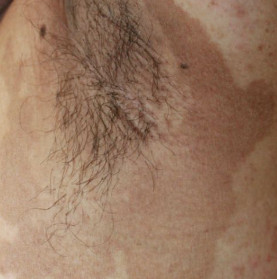Introduction
This is a structured guide for erythrasma treatment. Erythrasma is a bacterial infection that affects the skin and is usually caused by the bacterium Corynebacterium minutissimum. This pathogen tends to infect the outermost layer of the skin, called the stratum corneum, and is more commonly found in warm and moist areas of the body such as the skin folds in the axillary, inguinal, and interdigital regions. Interdigital erythrasma is the most common bacterial infection of the foot and the most frequent form of erythrasma. It can coexist with candida albicans or dermatophytes such as Epidermophyton, Microsporum, and Trichophyton. The clinical appearance of erythrasma can resemble other skin conditions such as candidiasis, dermatophytosis, pityriasis versicolor, and terra firma-forme dermatosis. Clearing Up Erythrasma requires a proper diagnosis and treatment. Here we will provide a structured guide for erythrasma treatment.

General instructions for erythrasma treatment
Eliminating predisposing factors can help to prevent erythrasma.
- Warm and humid climates can be a contributing factor, so avoiding excessive heat and moisture can be beneficial.
- Good hygiene practices, such as regular washing and drying of the affected skin, can help to prevent bacterial growth.
- Hyperhidrosis, or excessive sweating, can contribute to the development of erythrasma and may require treatment.
- Other factors that can predispose individuals to erythrasma include obesity, diabetes mellitus, advanced age, and immunosuppression.
- Managing these underlying conditions can help to reduce the risk of developing erythrasma.
Treatment options of erythrasma
Topical treatment options for erythrasma includes
- Clindamycin 2% : three times per day for a duration of seven days.
- Mupirocin: twice per day for a duration of 14 to 28 days.
- Fusidic acid 2% : twice per day for a duration of 14 days.
- Azole antifungals
- Clotrimazole: twice per day for 2 weeks.
- Miconazole: twice per day for 2 weeks.
- Whitfeld ointment (salicylic and benzoic acids) : twice daily for 7 days.
- Aluminum chloride 20% (Drying agent) : twice a day for 7 days.
Systemic treatment options for erythrasma includes
Oral antibiotics may be used to treat widespread erythrasma.
- Erythromycin : 250mg four times daily for two weeks.
- Tetracyclines : 250 mg four times daily for two weeks.
- Clarithromycin : 1 g single dose.
Photodynamic therapy[Ref]
Treatment of recurrent cases of erythrasma
Recurrent cases of erythrasma may require long-term treatment:
- Antiseptics, such as povidone-iodine, can be used to help prevent the growth and spread of bacteria.
- Drying agents, such as powders, can help to keep the affected skin dry and prevent moisture buildup.
- These treatments may need to be continued for an extended period of time to prevent recurrence of the infection.
Summary of Erythrasma Treatment
- The management of erythrasma involves identifying and addressing potential underlying risk factors that may contribute to the development or exacerbation of the condition.
- Topical treatment options may be appropriate for the management of localized erythrasma.
- While systemic therapies should be reserved for more widespread or severe cases
Sources
- Bolognia, J. L., Schaffer, J. V., & Cerroni, L. (2018). Dermatology (4th ed.). Elsevier.
- Griffiths, C., Barker, J., Bleiker, T. O., Chalmers, R., & Creamer, D. (Eds.). (2016). Rook’s textbook of dermatology. John Wiley & Sons.
- Erythrasma Revisited: Diagnosis, Differential Diagnoses, and Comprehensive Review of Treatment [Ref]